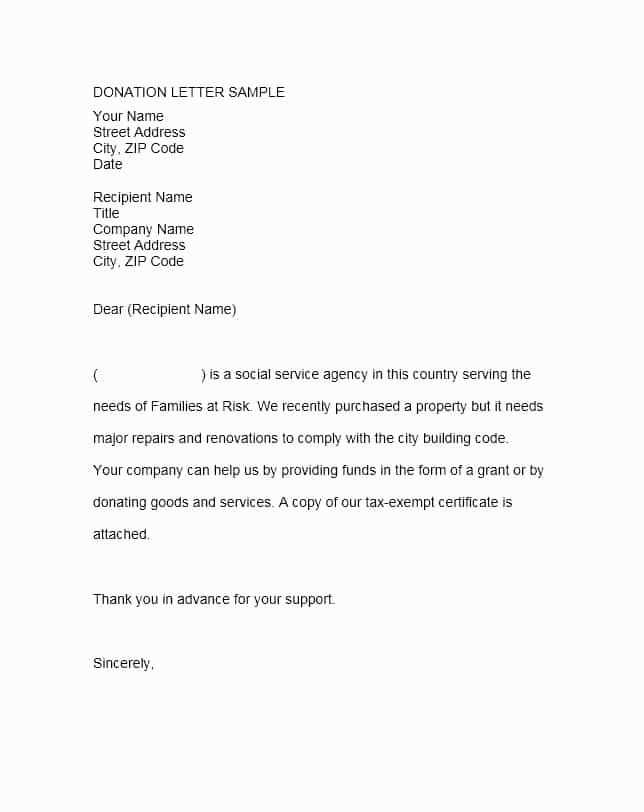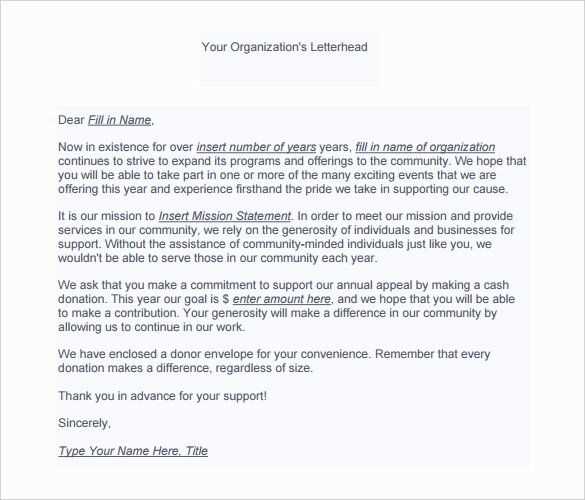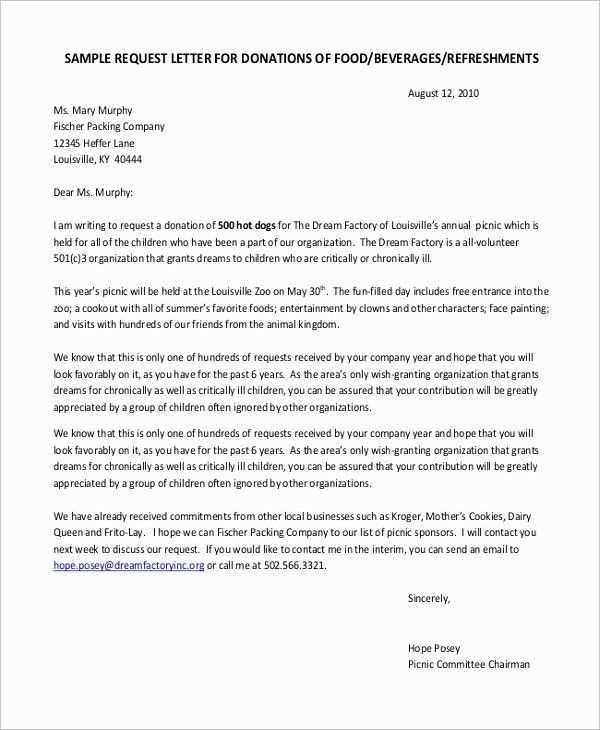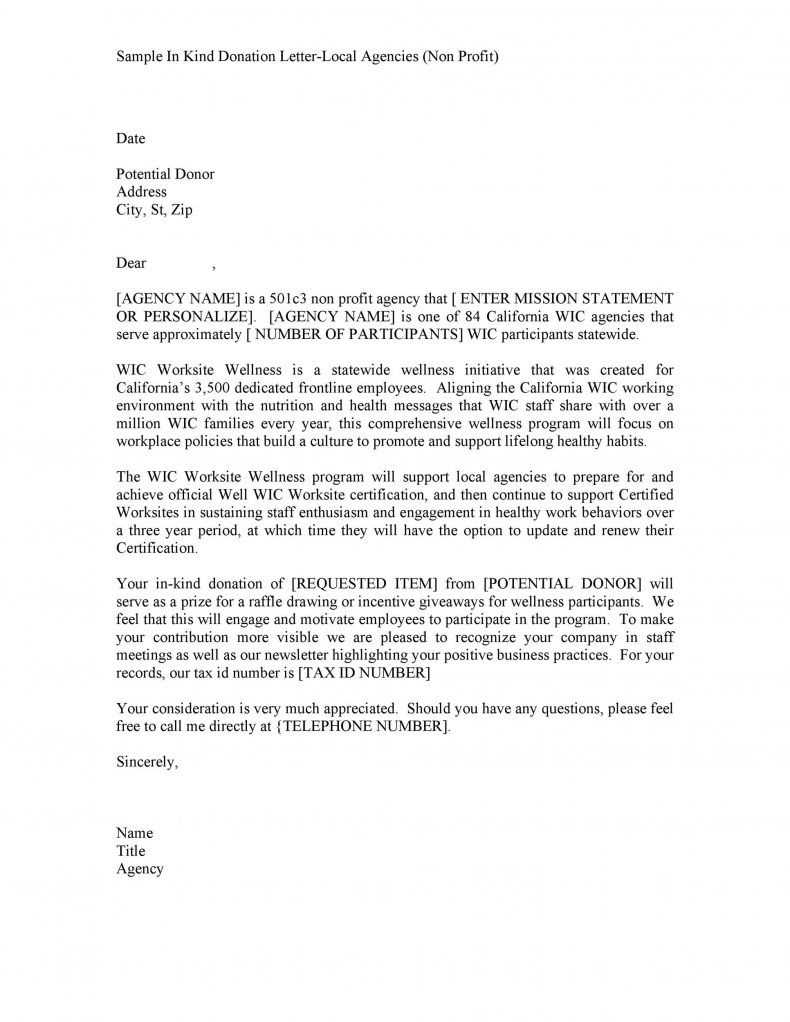Template non profit letter asking for donations from businesses

Crafting a donation request letter to businesses requires clarity, professionalism, and an engaging message. Begin by clearly stating the mission of your non-profit and how their contribution will make a tangible impact. Be direct about your needs, whether it’s funding, supplies, or volunteer support, and highlight specific projects that could benefit from their help.
Build a connection by acknowledging the company’s values or community involvement. This will show that you understand their role and align your cause with their goals. People are more likely to donate when they see a clear alignment between their corporate responsibility and the mission of your organization.
Provide clear instructions on how businesses can contribute, including any tax benefits or public recognition they may receive. Offer various donation methods, such as checks, online platforms, or in-kind contributions, making it easy for them to act. Close the letter by inviting them to contact you for more details or to discuss partnership opportunities. Keep the tone warm and approachable, while still professional.
Template Non-Profit Letter Asking for Donations from Businesses

Use this clear and structured template to approach businesses for donations. Craft your letter to emphasize how their support will directly impact your cause and the community.
| Template |
|---|
|
Dear [Business Name/Owner], We are reaching out to you with an exciting opportunity to make a real difference. [Your Non-Profit Organization’s Name] has been dedicated to [briefly state your mission, e.g., providing educational resources for underserved communities], and we believe that your business can help us achieve even greater impact. We are seeking donations in the form of [monetary contributions, goods, services] to support [specific program, event, or initiative]. Your generous support will help us [specific outcome or benefit of the donation, e.g., provide school supplies for 200 children or sponsor a community health clinic]. In exchange for your contribution, we offer [list any incentives such as recognition on social media, event signage, or website mentions]. Your business will gain visibility and the opportunity to showcase its commitment to making a difference in our community. We would be thrilled to discuss this opportunity further with you. Please feel free to contact me at [phone number] or [email address] to talk about how we can collaborate. Thank you for considering our request. We truly appreciate your support. Warm regards, [Your Name] [Your Title] [Non-Profit Organization Name] [Contact Information] |
How to Address the Recipient and Create a Professional Greeting
Begin by addressing the recipient by name whenever possible. This personal touch makes the letter feel more engaging and respectful. If you know the person’s title, include it–“Mr.”, “Ms.”, or “Dr.”–followed by their last name. This shows you have taken the time to research and adds a level of formality to the communication.
If you’re unsure of the recipient’s gender or title, opt for a neutral greeting like “Dear [Full Name],” or simply “Dear [Company Name] Representative” if addressing a business. Avoid generic greetings like “To Whom It May Concern,” which can come across as impersonal and lazy.
For a more formal tone, use a greeting like “Dear [Title] [Last Name],” while keeping the opening brief. A simple “Hello [First Name],” works well for a less formal approach, but ensure that the overall tone of your letter remains professional. Remember that your greeting sets the tone for the entire letter, so aim to match the recipient’s level of formality.
End the greeting with a comma for a polished, professional look. This small detail shows attention to writing conventions and further enhances the letter’s credibility.
Crafting a Persuasive Opening That Grabs Attention

To quickly engage a business and increase your chances of securing a donation, the opening of your letter must be direct and impactful. Start by addressing the recipient personally to create an immediate connection. Acknowledge their potential interest in making a positive impact within the community, and mention their specific business if possible.
Make It Relatable
Link your cause to the recipient’s values or business interests. For example, if you are reaching out to an eco-friendly company, highlight how their donation will contribute to environmental preservation. This makes the request more compelling and shows that you understand what matters to them.
Use a Compelling Statistic or Story
Begin with a brief, powerful statistic or a short story that captures the heart of your cause. For example, “Did you know that 1 in 5 children in our community go to bed hungry every night? With your support, we can change that.” A striking statistic or relatable story immediately brings your cause to life, prompting the reader to care about your mission.
- Be specific about the impact of donations.
- Avoid vague generalities–give concrete examples of how their donation will make a difference.
- Keep it short and to the point–your goal is to spark interest, not overwhelm with information.
With a well-crafted, attention-grabbing opening, you lay the groundwork for the rest of your letter. Make sure your message stands out from the start, so the reader feels compelled to continue and eventually contribute to your cause.
Clearly Explaining Your Organization’s Mission and Needs
State your mission in a direct and clear manner. Focus on what your organization does and the impact it aims to have. Instead of using abstract terms, use concrete examples that demonstrate your work and goals. For instance, “We provide meals to underprivileged families in the city, serving 500 families every month” tells the donor exactly what you do.
Explain why your cause needs support now. If there’s an urgent need, such as a shortage of resources or an ongoing project that requires funding, highlight this. Be specific about how the donations will be used. For example, “Your contribution will fund our food pantry, allowing us to serve 100 additional families this month.”
Clarify the impact of a donation. Donors want to understand how their money will make a difference. Instead of vague promises, offer a breakdown: “A $500 donation will cover food for 50 families for one month.” This gives donors a clear understanding of their potential impact.
Make it personal. Share a short story or example that demonstrates how your organization has helped an individual or community. Showing tangible results will encourage donors to feel connected to your cause.
Providing Specific Donation Options for Businesses
Offer businesses clear, targeted options for donating, such as cash, in-kind contributions, or services. Specify how each donation type benefits your organization and community. For example, a monetary donation can be directly allocated to a specific program or initiative. In-kind donations, such as products or equipment, can be listed with examples of how they meet immediate needs.
Provide tiered giving levels, such as “Bronze,” “Silver,” and “Gold,” with corresponding benefits for each level. This allows businesses to choose a donation amount that fits their budget and still receive recognition for their support. Highlight what each tier helps fund, like scholarships, equipment, or community outreach efforts.
Include options for recurring donations, which businesses can set up for consistent support. Offer both monthly and annual options to cater to different financial planning preferences. Encourage businesses to make the process easy, with a clear, simple method for setting up these donations.
For businesses with products or services to donate, suggest specific needs based on your organization’s current goals. For instance, a food bank may request a specific type of non-perishable food, or a school may need tech supplies. Providing these examples makes it easier for businesses to know how they can contribute.
Finally, ensure that businesses understand how they will be recognized for their generosity. Whether through signage, social media shout-outs, or inclusion in annual reports, businesses appreciate knowing that their contributions will be acknowledged in ways that align with their marketing goals.
Highlighting the Benefits for the Business in Supporting Your Cause
Partnering with a nonprofit offers businesses a chance to enhance their brand image and build a positive reputation within the community. Customers and clients often view businesses that contribute to charitable causes as more trustworthy and socially responsible, which can lead to increased customer loyalty and long-term relationships.
When a business supports a cause, it can also gain valuable exposure. Your nonprofit’s marketing efforts, whether through events, social media, or newsletters, can highlight the business’s contribution to a meaningful cause. This visibility can lead to greater brand recognition among potential customers who align with the nonprofit’s values.
Businesses also have the opportunity to strengthen employee engagement by supporting a cause. Many employees feel more motivated and proud to work for companies that prioritize social impact. This can improve morale, boost productivity, and help retain talent.
Additionally, businesses can benefit from tax incentives when donating to a registered nonprofit. Contributions may be deductible, providing both financial savings and a positive impact on their bottom line.
Lastly, by working with a nonprofit, businesses gain access to a network of like-minded individuals and organizations, potentially opening doors to new collaborations, partnerships, and opportunities for growth.
Polite Closing with a Call to Action and Contact Information

End your donation request letter with a clear and respectful call to action, encouraging the recipient to act while making it easy for them to reach you. This part should be confident yet courteous, motivating businesses to take the next step without pressure.
Make the Ask Clear
Be straightforward about what you need from them. Specify the type of donation you’re requesting and how it will be used. If you’re seeking a monetary donation, mention the range or amount that would make a meaningful impact.
- Example: “A donation of $500 would help us provide meals for 100 families this month.”
- Example: “Your contribution of any size will help us continue our mission of providing resources to underprivileged communities.”
Offer Easy Ways to Donate
Provide simple instructions on how to contribute. Include multiple options like online donation portals, checks, or direct contact with your organization. Ensure that businesses know how quick and secure the process is.
- Example: “Visit our website at www.example.org to donate securely online.”
- Example: “Checks can be made out to [Organization Name] and mailed to [Address].”
Provide Contact Information
End your letter by offering your contact details in case the business has questions or needs additional information. Make it easy for them to connect with you directly.
- Example: “Please feel free to reach out at [Phone Number] or email us at [Email Address].”
- Example: “If you’d like to discuss other ways to get involved, don’t hesitate to call or email me personally at [Your Contact Info].”
Thank them for their time and consideration, making sure to convey your appreciation in advance for their support.